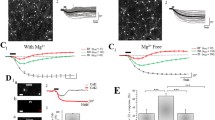Abstract
In a recent review published in Molecular Neurobiology, Kamat and colleagues (Mol Neurobiol. 2014 Dec;50(3):852–65) highlighted the cellular and molecular mechanisms involved in Okadaic acid (OKA)-induced neurotoxicity. In this review, the authors underline a wide range of pathological signaling pathways involved in OKA-induced neurotoxicity; however, the role of glutamate was only briefly described. We believe that the hyperactivation of the glutamatergic system is a key pathophysiological player in OKA-induced neurotoxicity and deserves serious attention. In this commentary, we propose an integrative model linking glutamate and PP2A and put forward some unanswered questions.

Similar content being viewed by others
References
Gong CX, Singh TJ, Grundke-Iqbal I, Iqbal K (1993) Phosphoprotein phosphatase activities in Alzheimer disease brain. J Neurochem 61(3):921–927
Gong CX, Grundke-Iqbal I, Damuni Z, Iqbal K (1994) Dephosphorylation of microtubule-associated protein tau by protein phosphatase-1 and -2C and its implication in Alzheimer disease. FEBS Lett 341(1):94–98
Iqbal K, Alonso Adel C, Chen S, Chohan MO, El-Akkad E, Gong CX, Khatoon S, Li B et al (2005) Tau pathology in Alzheimer disease and other tauopathies. Biochim Biophys Acta 1739(2–3):198–210. doi:10.1016/j.bbadis.2004.09.008
Zimmer ER, Leuzy A, Bhat V, Gauthier S, Rosa-Neto P (2014) In vivo tracking of tau pathology using positron emission tomography (PET) molecular imaging in small animals. Transl Neurodegen 3(1):6. doi:10.1186/2047-9158-3-6
Sontag JM, Sontag E (2014) Protein phosphatase 2A dysfunction in Alzheimer’s disease. Front Mol Neurosci 7:16. doi:10.3389/fnmol.2014.00016
Arif M, Kazim SF, Grundke-Iqbal I, Garruto RM, Iqbal K (2014) Tau pathology involves protein phosphatase 2A in parkinsonism-dementia of Guam. Proc Natl Acad Sci U S A 111(3):1144–1149. doi:10.1073/pnas.1322614111
Kamat PK, Rai S, Swarnkar S, Shukla R, Nath C (2014) Molecular and cellular mechanism of okadaic acid (OKA)-induced neurotoxicity: a novel tool for Alzheimer’s disease therapeutic application. Mol Neurobiol 50(3):852–865. doi:10.1007/s12035-014-8699-4
Cohen P, Klumpp S, Schelling DL (1989) An improved procedure for identifying and quantitating protein phosphatases in mammalian tissues. FEBS Lett 250(2):596–600
Gong CX, Lidsky T, Wegiel J, Zuck L, Grundke-Iqbal I, Iqbal K (2000) Phosphorylation of microtubule-associated protein tau is regulated by protein phosphatase 2A in mammalian brain. Implications for neurofibrillary degeneration in Alzheimer’s disease. J Biol Chem 275(8):5535–5544
Liu F, Grundke-Iqbal I, Iqbal K, Gong CX (2005) Contributions of protein phosphatases PP1, PP2A, PP2B and PP5 to the regulation of tau phosphorylation. Euro J Neurosci 22(8):1942–1950. doi:10.1111/j.1460-9568.2005.04391.x
Zimmer ER, Kalinine E, Haas CB, Torrez VR, Souza DO, Muller AP, Portela LV (2012) Pretreatment with memantine prevents Alzheimer-like alterations induced by intrahippocampal okadaic acid administration in rats. Curr Alzheimer Res 9(10):1182–1190
Kamat PK, Rai S, Swarnkar S, Shukla R, Nath C (2014) Mechanism of synapse redox stress in Okadaic acid (ICV) induced memory impairment: role of NMDA receptor. Neurochem Int 76:32–41. doi:10.1016/j.neuint.2014.06.012
Seo J, Giusti-Rodriguez P, Zhou Y, Rudenko A, Cho S, Ota KT, Park C, Patzke H et al (2014) Activity-dependent p25 generation regulates synaptic plasticity and Abeta-induced cognitive impairment. Cell 157(2):486–498. doi:10.1016/j.cell.2014.01.065
Robinson DM, Keating GM (2006) Memantine: a review of its use in Alzheimer’s disease. Drugs 66(11):1515–1534
Conflict of Interest
The authors declare that they have no competing interests.
Author information
Authors and Affiliations
Corresponding author
Rights and permissions
About this article
Cite this article
Zimmer, E.R., Leuzy, A., Souza, D.O. et al. Inhibition of Protein Phosphatase 2A: Focus on the Glutamatergic System. Mol Neurobiol 53, 3753–3755 (2016). https://doi.org/10.1007/s12035-015-9321-0
Received:
Accepted:
Published:
Issue Date:
DOI: https://doi.org/10.1007/s12035-015-9321-0




